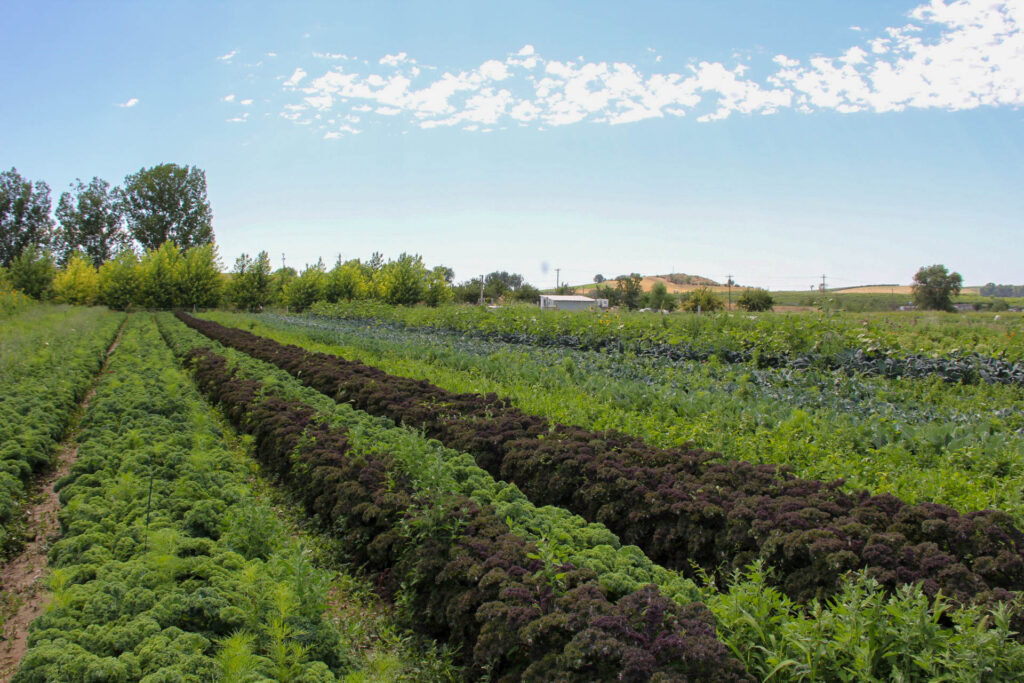Kale and other greens grow in a field at Peaceful Belly Farm in Caldwell, Idaho on July 7, 2022. (Carly Whitmore / U.S. Department of Agriculture)
Two years ago, Galen Lee was trying to buy a plot of land in Fruitland to farm, but he was outbid by a housing developer for twice as much as he could offer.
Lee is a fourth generation farmer in Payette County, and he raises sugar beets, peppermint, asparagus, alfalfa, corn and beef.
This year, those developers converted 20 acres of that piece of land in Fruitland into housing developments. Next year, they will develop it into more housing, Lee said.
“It’s frustrating as a farmer, but it makes sense economically,” he told the Idaho Capital Sun.
Galen Lee stands in front of a sugar beet harvester. (Courtesy of Idaho Farm Bureau)
Lee is one of many farmers who is competing against other industries for land.
Between 2017 and 2022, Idaho lost 2,119 farms and 144,000 acres of farmland, according to the U.S. Census of Agriculture’s 2022 data, which was released in February.
And the main reason behind Idaho’s loss in farmland is an increase in population growth and the demand for development, Sean Ellis, spokesperson for the Idaho Farm Bureau told the Sun.
According to the U.S. Census Bureau, Idaho’s population increased 17% between 2010 to 2020, or by about 272,000 people. That population growth has increased the demand for housing in Idaho, he said.
Kootenai County, the Treasure Valley, Twin Falls County, Franklin County and counties near Idaho Falls had the highest increase in housing units to supplement population growth, census data shows.
“In a lot of cases, developers are offering someone a pretty penny for their land, and what they’re offering is too much and too attractive to turn down,” Ellis told the Sun.
Despite Idaho’s loss in farmland, Idaho’s agricultural sector still runs strong as modern farming practices have helped farmers produce more with less land.
Idaho farmers produce more with less
Idaho State Statistician Ben Johnson told the Sun that the data in the agricultural census won’t show causation for loss in farmland, but it may support certain claims such as urban sprawl or conversion to other environmental uses.
“A couple of data points that could be concerning, in Idaho it shows 60% of farms are reporting net losses and 60% of producers’ primary occupation is not farming,” he said. “The largest loss in farm numbers are in the smaller farm categories, which could suggest that it’s not economically prudent to keep putting money into a ‘hobby farm’ especially with the rise in costs and the incentive to sell with record high land values.”
Idaho is not alone in having a decrease in farmland.
Idaho and neighboring states are a part of a national trend of decreasing farmland. According to the latest data from the U.S. Census of Agriculture, the country lost more than 20 million acres of farmland, and about 142,000 farms between 2017 and 2022.
“Farmland in the U.S. has continued to shrink for decades, but if you look at the facts, farmers right now in the U.S. as a whole are producing a lot more food on a lot less land than they did four decades ago,” Ellis told the Sun.
Agricultural census data shows the country sold more than $540 billion worth of agricultural products in 2022, an increase from $388 billion in 2017 — when there was more farmland. While the COVID-19 pandemic and inflation jumped prices to record highs in 2022, Johnson said the cost of production for farms also jumped up 30% nationally and 40% in Idaho in comparison to 2017.
This increase in sales is possible because farmers have partnered with research institutions such as the University of Idaho to find ways to increase yields, Ellis said.
Some examples include researching methods to reduce tillage, exploring which soil organisms can enhance wheat yields, and developing tools to manage farm water from a smartphone, John O’ Connell, spokesperson for the University of Idaho told the Sun.
“So, that’s a good thing, but the loss in farmland is not a good thing,” Ellis said. “It certainly is concerning, but it’s not catastrophic because we are producing more food than we ever had.”
Jan Roeser, an economist with the Idaho Department of Labor, affirmed Ellis’ thoughts in a July report. While Idaho’s loss in farmland sounds alarming, Roeser said the decrease in farmland is the result of Idaho farmers using more automation and practices learned through research and development to create higher yields.
“While Idaho’s agricultural acreage continues to face ongoing development challenges, human ingenuity and consumer demand for niche products are creating opportunities and advancing efficient farm practices for future generations,” she said in the report.
According to the agricultural census, Idaho produced $10.8 billion worth of agricultural products, a spike up from $7.6 billion in 2017.
“The automation and adapting practices have kept our levels of production resilient,” Roeser told the Sun in an email.
Lee, who owns 1,200 acres of land, said he recognizes the role agricultural research has played in helping increase production.
“Absolutely, we’re improving all the time,” he said about modern farming tactics. “Our yields are getting better. But once the land comes out of production and goes to houses, it never goes back. As we lose this farm ground, we’re losing the capability to produce food.”
SUPPORT NEWS YOU TRUST.

